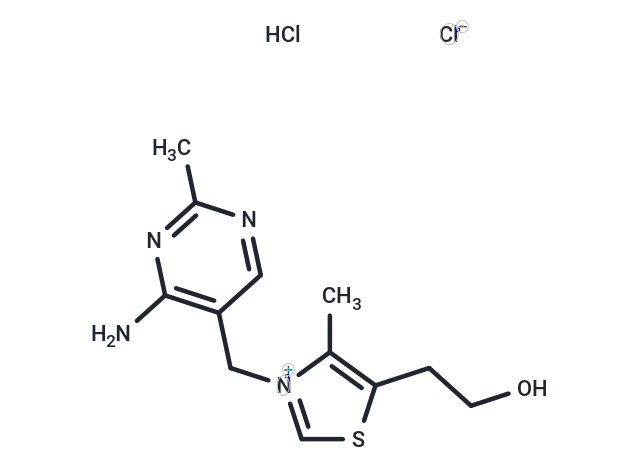Shopping Cart
- Remove All
 Your shopping cart is currently empty
Your shopping cart is currently empty

Thiamine hydrochloride (Vitamin B1) is the hydrochloride salt form of thiamine, a vitamin essential for aerobic metabolism, cell growth, transmission of nerve impulses and acetylcholine synthesis. Upon hydrolysis, Thiamine hydrochloride (Vitamin B1) is phosphorylated by thiamine diphosphokinase to form active thiamine pyrophosphate (TPP), also known as cocarboxylase. TPP is a coenzyme for many enzymatic activities involving fatty acid, amino acid and carbohydrate metabolism.

| Pack Size | Price | Availability | Quantity |
|---|---|---|---|
| 100 mg | $50 | In Stock | |
| 1 g | $68 | In Stock |
| Description | Thiamine hydrochloride (Vitamin B1) is the hydrochloride salt form of thiamine, a vitamin essential for aerobic metabolism, cell growth, transmission of nerve impulses and acetylcholine synthesis. Upon hydrolysis, Thiamine hydrochloride (Vitamin B1) is phosphorylated by thiamine diphosphokinase to form active thiamine pyrophosphate (TPP), also known as cocarboxylase. TPP is a coenzyme for many enzymatic activities involving fatty acid, amino acid and carbohydrate metabolism. |
| In vitro | Thiamine (50 mM), in addition to its nutritional value, induces systemic acquired resistance (SAR) in rice, tobacco, cucumber, and Arabidopsis. Thiamine-treated rice, Arabidopsis (Arabidopsis thaliana), and vegetable crop plants shows resistance to fungal, bacterial, and viral infections. Thiamine treatment induces the transient expression of pathogenesis-related (PR) genes in rice and other plants. In addition, Thiamine treatment potentiates stronger and more rapid PR gene expression and the up-regulation of protein kinase C activity. [1] Vitamin B1 (10 μM) prevents acetaldehyde-induced inhibition of myocyte shortening in adult rat ventricular myocytes. Vitamin B1 (10 μM) effectively blunts the acetaldehyde-induced depression in ±dL/dt in adult rat ventricular myocytes. Vitamin B1 (10 μM) prevents acetaldehyde-induced shortening of time-to-peak shortening in adult rat ventricular myocytes. Vitamin B1 (10 μM) prevents acetaldehyde-induced elevation in both protein carbonyl formation and caspase-3 activation in adult rat ventricular myocytes. [2] Thiamine uptake is energy- and temperature-dependent, pH-sensitive, Na+-independent, saturable at both the nanomolar (apparent Km, 30 nM) and the micromolar concentration ranges in ARPE-19 cells. Uptake of Thiamine is adaptively regulated by extracellular substrate level via transcriptionally mediated mechanisms that involve both hTHTR-1 and hTHTR-2 in ARPE-19 cells, it is also regulated by an intracellular Ca2+-calmodulin-mediated pathway. [3] Thiamine-responsive megaloblastic anemia (TRMA) fibroblasts are rescued from death with 10 nM-30 nM Thiamine. Normal fibroblasts exhibits saturable, high-affinity thiamine uptake (Km 400 nM-550 nM; Vmax 11 pmol/min/1×106 cells), while TRMA fibroblasts lacks detectable high-affinity uptake. At 30 nM Thiamine, the rate of uptake of Thiamine by TRMA fibroblasts is 10-fold less than that of wild-type, which explains the increased apoptosis of TRMA fibroblasts. [4] |
| In vivo | Thiamine deficiency results in amyloid precursor protein immunoreactivity accumulated in swollen neurites within, or around lesions in rats, or in abnormal clusters in mice. [5] |
| Alias | Vitamin B1 hydrochloride, Thiamine HCl, Thiamine chloride hydrochloride |
| Molecular Weight | 337.27 |
| Formula | C12H18Cl2N4OS |
| Cas No. | 67-03-8 |
| Smiles | Cl.[Cl-].CC1=C(CCO)SC=[N+]1CC1=C(N)N=C(C)N=C1 |
| Relative Density. | 1.401 g/cm3 |
| Storage | Powder: -20°C for 3 years | In solvent: -80°C for 1 year | Shipping with blue ice. | ||||||||||||||||||||||||||||||||||||||||
| Solubility Information | H2O: 95 mg/mL (281.67 mM), Sonication is recommended. DMSO: 3.37 mg/mL (10.01 mM), Sonication is recommended. | ||||||||||||||||||||||||||||||||||||||||
Solution Preparation Table | |||||||||||||||||||||||||||||||||||||||||
DMSO/H2O
H2O
| |||||||||||||||||||||||||||||||||||||||||

Copyright © 2015-2025 TargetMol Chemicals Inc. All Rights Reserved.